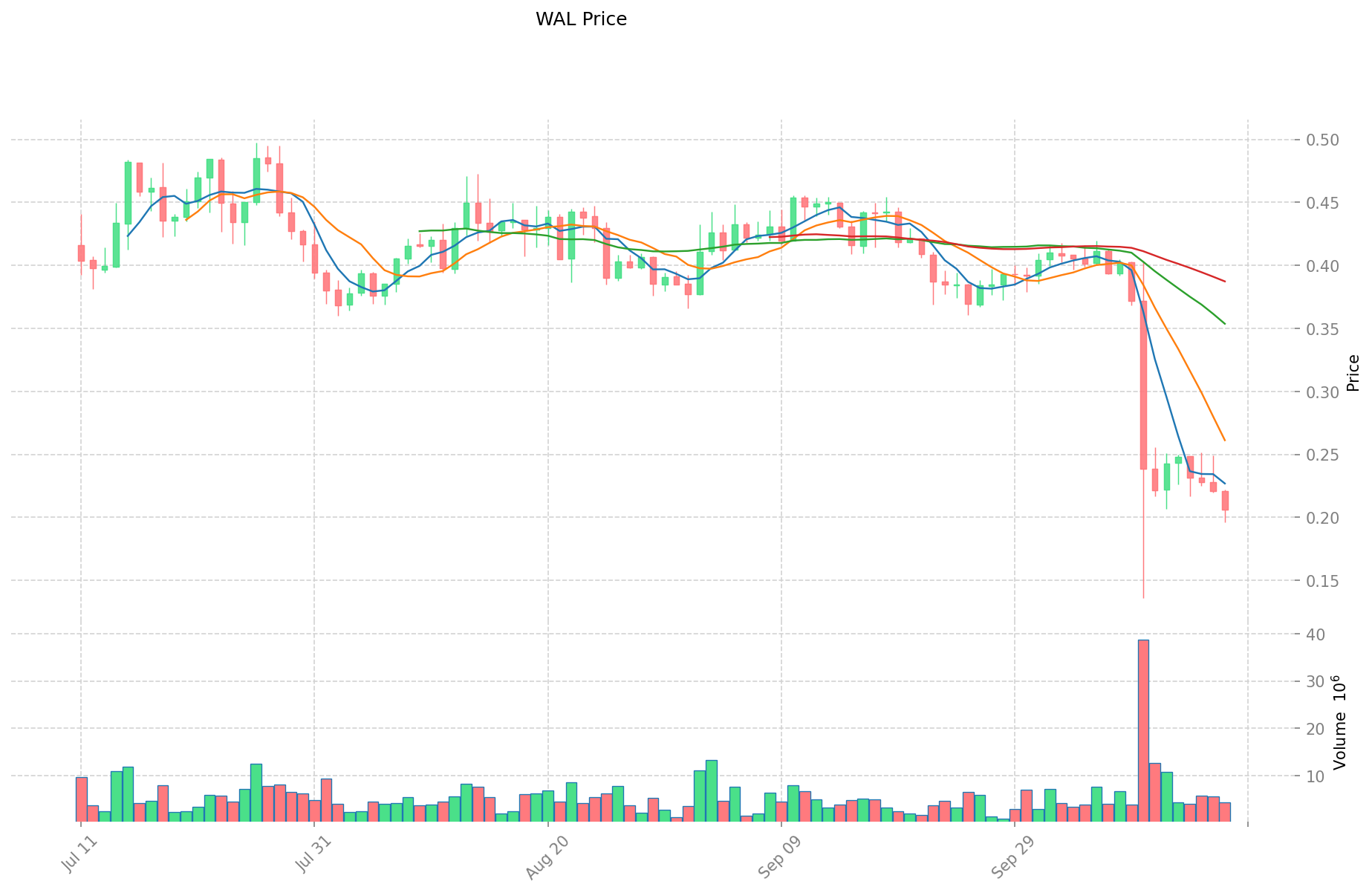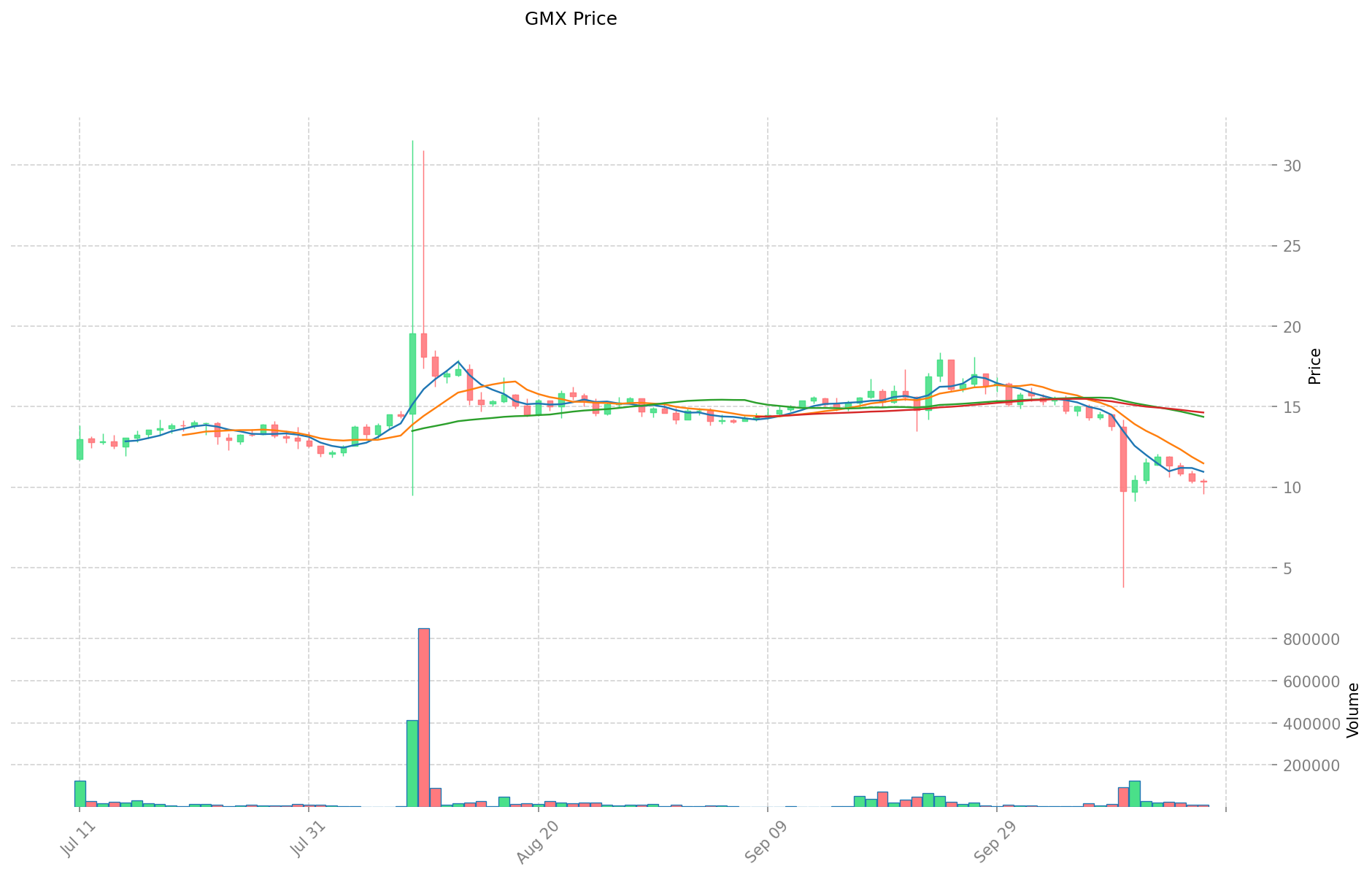WAL ile GMX: En İyi Alım Satım Deneyimi İçin İki Lider Kripto Para Borsasının Karşılaştırılması


Giriş: WAL ve GMX Yatırımlarının Karşılaştırılması
Kripto para piyasasında WAL ile GMX arasındaki kıyaslama, yatırımcılar için önemli bir gündem maddesidir. Her iki varlık, piyasa değeri sıralaması, kullanım alanları ve fiyat performansı açısından belirgin ayrışırken, kripto varlık ekosisteminde farklı konumları temsil etmektedir.
Walrus (WAL): Lansmanından bu yana merkeziyetsiz veri depolama yeteneğiyle piyasa tarafından ilgi görmüştür.
GMX (GMX): Kuruluşundan itibaren merkeziyetsiz perpetual borsa olarak öne çıkmış, merkeziyetsiz finans alanında yenilikçi projelerden biri olarak kabul edilmiştir.
Bu makalede; WAL ve GMX’in yatırım değerleri, tarihsel fiyat hareketleri, arz mekanizmaları, kurumsal benimseme, teknolojik ekosistemler ve gelecek tahminleri üzerinden kapsamlı biçimde analiz edilerek yatırımcıların en çok sorduğu şu soruya yanıt aranacak:
"Şu anda hangisi daha iyi bir yatırım fırsatı sunuyor?"
I. Fiyat Geçmişi Karşılaştırması ve Güncel Piyasa Görünümü
WAL (Coin A) ve GMX (Coin B) Tarihsel Fiyat Eğilimleri
- 2025: WAL, 27 Mart'ta $0,9719 ile zirve yapıp, 10 Ekim'de $0,1357 ile en düşük seviyesini gördü.
- 2023: GMX, 18 Nisan’da $91,07 ile rekor kırdı ve önemli fiyat dalgalanmaları yaşadı.
- Kıyas: WAL, 2025’te kısa sürede zirveden en düşük seviyeye hızlı düşerken; GMX, 2023’teki zirveden bugüne, 11 Ekim 2025’te $6,92’ye ulaşan daha uzun vadeli bir değer kaybı yaşadı.
Güncel Piyasa Durumu (18 Ekim 2025)
- WAL güncel fiyat: $0,2058
- GMX güncel fiyat: $10,31
- 24 saatlik işlem hacmi: WAL $911.899,93 — GMX $117.637,34
- Piyasa Duyarlılık Endeksi (Korku & Açgözlülük Endeksi): 22 (Aşırı Korku)
Anlık fiyatları incelemek için tıklayın:
- WAL güncel fiyatı Piyasa Fiyatı
- GMX güncel fiyatı Piyasa Fiyatı


II. WAL ve GMX Yatırım Değerini Etkileyen Temel Faktörler
Arz Mekanizması Karşılaştırması (Tokenomik)
-
WAL: Maksimum 2 milyon token ile sabit arz modeli; 400 bin ekosistem için ayrıldı, 1,6 milyon GMX staker’larına dağıtıldı
-
GMX: Deflasyonist model; ücretlerin %70’i token geri alımı ve staker’lara dağıtımda kullanılır
-
📌 Tarihsel örüntü: WAL’in sabit arzı, uzun vadede değer açısından kıtlık yaratabilir; GMX’in ücret bazlı geri alım modeli ise token değerini protokol kullanımı ve işlem hacmine doğrudan bağlar.
Kurumsal Benimseme ve Piyasa Uygulamaları
- Kurumsal tutum: GMX, güçlü geçmiş performansı ve daha yüksek TVL’si ($522M — WAL $31M) ile kurumsal yatırımcıların ilgisini çekmektedir
- Kurumsal kullanım: GMX, daha fazla işlem çifti ve perpetual işlemlerde geniş tanınırlık avantajına sahip; WAL ise yeni ve fiyatlandırma ile likiditeye odaklanıyor
- Düzenleyici yaklaşım: İki protokol de merkeziyetsiz finans alanında, DEX standartlarında benzer regülasyon koşullarında faaliyet gösterir
Teknik Gelişim ve Ekosistem Oluşumu
- WAL teknik yenilikleri: Sıfır kayma ile işlem sunan VM tabanlı oracle ve likidite yönetimi sistemi
- GMX teknik gelişimi: Arbitrum ve Avalanche üzerinde çok zincirli varlık, düşük işlem ücreti ve düşük fiyat etkisi ile kanıtlanmış performans
- Ekosistem kıyaslaması: GMX, yüksek işlem hacmi ($5,9B — WAL $236,9M) ve uzun vadeli geçmişiyle olgun bir ekosistem sunarken; WAL, yenilikçi teknolojik avantajlara sahip olup ekosistemini geliştirmeye devam ediyor
Makroekonomik Faktörler ve Piyasa Döngüleri
- Enflasyon dönemi performansı: Her iki protokol de işlem ücretlerinden gelir elde ettiği için piyasa oynaklığında avantaj sağlayabilir
- Para politikası etkisi: Faiz oranları, iki platformda da işlem hacmini doğrudan etkiler; GMX farklı piyasa döngülerinde dayanıklılığını göstermiştir
- Jeopolitik faktörler: WAL ve GMX gibi merkeziyetsiz borsalar, jeopolitik belirsizlikte saklama gerektirmeyen finansal hizmetlere olan talebin artışından fayda sağlayabilir III. 2025-2030 Fiyat Tahmini: WAL vs GMX
Kısa Vadeli Tahmin (2025)
- WAL: Muhafazakar $0,192417 - $0,2069 | İyimser $0,2069 - $0,26897
- GMX: Muhafazakar $7,8356 - $10,31 | İyimser $10,31 - $14,2278
Orta Vadeli Tahmin (2027)
- WAL, büyüme aşamasına geçebilir; tahmini fiyat aralığı $0,162937888 - $0,361518439
- GMX, yükseliş piyasasına girebilir; tahmini fiyat aralığı $10,35004404 - $18,24876186
- Temel etkenler: Kurumsal sermaye girişi, ETF’ler, ekosistem gelişimi
Uzun Vadeli Tahmin (2030)
- WAL: Temel senaryo $0,374424774567525 - $0,539171675377236 | İyimser senaryo $0,539171675377236+
- GMX: Temel senaryo $17,88349723012125 - $20,387186842338225 | İyimser senaryo $20,387186842338225+
Yasal Uyarı: Bu analiz, geçmiş veriler ve güncel piyasa eğilimlerine dayanır. Kripto para piyasaları yüksek volatiliteye ve öngörülemezliğe sahiptir. Bu bilgi yatırım tavsiyesi değildir. Yatırım kararı öncesinde kendi araştırmanızı yapmalısınız.
WAL:
| Yıl | Tahmini En Yüksek Fiyat | Tahmini Ortalama Fiyat | Tahmini En Düşük Fiyat | Değişim Oranı (%) |
|---|---|---|---|---|
| 2025 | 0,26897 | 0,2069 | 0,192417 | 0 |
| 2026 | 0,2712459 | 0,237935 | 0,14989905 | 15 |
| 2027 | 0,361518439 | 0,25459045 | 0,162937888 | 23 |
| 2028 | 0,37582642229 | 0,3080544445 | 0,16634940003 | 49 |
| 2029 | 0,40690911574005 | 0,341940433395 | 0,24961651637835 | 65 |
| 2030 | 0,539171675377236 | 0,374424774567525 | 0,359447783584824 | 81 |
GMX:
| Yıl | Tahmini En Yüksek Fiyat | Tahmini Ortalama Fiyat | Tahmini En Düşük Fiyat | Değişim Oranı (%) |
|---|---|---|---|---|
| 2025 | 14,2278 | 10,31 | 7,8356 | 0 |
| 2026 | 14,968058 | 12,2689 | 8,58823 | 19 |
| 2027 | 18,24876186 | 13,618479 | 10,35004404 | 32 |
| 2028 | 18,9610083117 | 15,93362043 | 15,2962756128 | 54 |
| 2029 | 18,3196800893925 | 17,44731437085 | 11,166281197344 | 69 |
| 2030 | 20,387186842338225 | 17,88349723012125 | 16,273982479410337 | 73 |
IV. Yatırım Stratejisi Kıyaslaması: WAL vs GMX
Uzun Vadeli ve Kısa Vadeli Yatırım Stratejileri
- WAL: Yenilikçi DeFi çözümlerine ve ekosistem büyüme potansiyeline odaklanan yatırımcılar için uygundur
- GMX: Merkeziyetsiz ticarette kanıtlanmış geçmiş performansa sahip, yerleşik platform arayan yatırımcılar için uygundur
Risk Yönetimi ve Varlık Dağılımı
- Temkinli yatırımcılar: WAL %20 — GMX %80
- Agresif yatırımcılar: WAL %40 — GMX %60
- Koruma araçları: Stablecoin tahsisi, opsiyonlar, döviz çeşitlendirmesi
V. Potansiyel Risk Kıyaslaması
Piyasa Riskleri
- WAL: Düşük piyasa değeri ve işlem hacmi nedeniyle daha yüksek volatilite
- GMX: DeFi genel piyasa trendlerine ve rakip merkeziyetsiz borsalara karşı hassas
Teknik Riskler
- WAL: Ölçeklenebilirlik, ağ istikrarı ve VM tabanlı oracle sisteminde potansiyel zafiyetler
- GMX: Akıllı kontrat güvenliği, likidite havuzu riskleri ve zincirler arası köprü zafiyetleri
Düzenleyici Riskler
- Küresel regülasyonlar, her iki protokolü de merkeziyetsiz finans platformları olarak benzer şekilde etkileyebilir
VI. Sonuç: Hangisi Daha Avantajlı?
📌 Yatırım Değeri Özeti:
- WAL avantajları: Yenilikçi teknoloji, sabit arz modeli, ekosistem büyüme potansiyeli
- GMX avantajları: Yerleşik piyasa varlığı, yüksek likidite, merkeziyetsiz perpetual ticarette kendini kanıtlamış geçmiş
✅ Yatırım Tavsiyesi:
- Yeni yatırımcılar: WAL’a daha küçük bir pay ayırarak yenilikçi DeFi teknolojisine erişim sağlayabilir, GMX’e ise daha büyük bir pozisyonla yatırım yapabilir
- Tecrübeli yatırımcılar: GMX’e ağırlık verirken WAL’deki teknolojik gelişmeleri yakından takip ederek dengeli portföy oluşturabilir
- Kurumsal yatırımcılar: Yüksek likidite ve gelişmiş ekosistem nedeniyle GMX’e odaklanmalı, WAL’ı portföy çeşitlendirmesi için küçük ölçekli olarak değerlendirmelidir
⚠️ Risk Uyarısı: Kripto para piyasaları yüksek volatiliteye sahiptir. Bu makale yatırım tavsiyesi değildir. None
VII. Sıkça Sorulan Sorular
S1: WAL ve GMX arasındaki ana farklar nelerdir? C: WAL, merkeziyetsiz veri depolamaya odaklanan ve sabit arz modeliyle öne çıkan yeni bir projedir; GMX ise deflasyonist modelle çalışan, yerleşik ve merkeziyetsiz perpetual borsadır. GMX’in piyasa değeri, işlem hacmi ve kurumsal benimseme düzeyi daha yüksektir.
S2: Son dönemde hangi coin daha iyi fiyat performansı gösterdi? C: GMX, son fiyat hareketlerinde daha istikrarlı bir seyir izledi. WAL, 2025’te zirveden dip seviyeye hızla gerilerken; GMX, 2023’teki zirveden itibaren daha uzun vadeli bir düşüş yaşadı.
S3: WAL ve GMX’in arz mekanizmaları nasıl farklılaşıyor? C: WAL, maksimum 2 milyon token ile sabit arz modelini kullanır; GMX ise ücretlerin %70’inin token geri alımı ve staker’lara dağıtımında kullanıldığı deflasyonist modele sahiptir.
S4: Hangi coin uzun vadeli yatırım için daha uygun görülüyor? C: Her iki coin’in de uzun vadeli potansiyeli olmakla birlikte, GMX genellikle yerleşik piyasa varlığı, yüksek likiditesi ve merkeziyetsiz perpetual ticaretteki başarısı nedeniyle daha uygun kabul edilir.
S5: WAL ve GMX için başlıca yatırım riskleri nelerdir? C: WAL, düşük piyasa değeri ve işlem hacmi nedeniyle yüksek volatilite ve VM tabanlı oracle sisteminden doğan teknik risklere sahiptir; GMX ise genel DeFi piyasası trendlerine, rakip merkeziyetsiz borsalara ve akıllı kontrat güvenliğine ilişkin risklere açıktır.
S6: Kurumsal yatırımcılar WAL ve GMX’i nasıl değerlendiriyor? C: Kurumsal yatırımcılar, yüksek likidite ve gelişmiş ekosistem nedeniyle GMX’e daha fazla odaklanır. WAL ise portföy çeşitlendirmesi için sınırlı ölçekli olarak değerlendirilebilir.
S7: 2030’da WAL ve GMX için öngörülen fiyat aralıkları nedir? C: Tahminlere göre, WAL’ın 2030 temel senaryosu $0,374424774567525 - $0,539171675377236; GMX’in ise $17,88349723012125 - $20,387186842338225 aralığındadır. Ancak bu tahminler kesin değildir ve yatırım tavsiyesi olarak değerlendirilmemelidir.

Gains Network (GNS) İyi Bir Yatırım mı?: Bu Kaldıraçlı Alım Satım Protokolünün Potansiyeli ve Riskleri Üzerine Analiz

Aster (ASTER) Ne Zaman Alınır: Girişinizi Akıllıca Zamanlama

ULTI ve DYDX: İki Lider Merkeziyetsiz Türev Platformunun Karşılaştırılması

LION vs GMX: DeFi Ekosistemini Yeniden Şekillendiren Merkeziyetsiz Borsaların Mücadelesi

FURY vs DYDX: Merkeziyetsiz Türev İşlemlerinde Liderlik Yarışı

SAO vs GMX: Sanal Gerçeklik Oyunlarında Zirvedeki Mücadele

Tomarket Daily Combo 20 Aralık 2025

Blockchain ortamında Dijital Varlıkların Güvenli Anahtar kullanılarak transferi

A8 Nedir: Bu Gelişmiş Teknoloji Platformunu Anlamaya Yönelik Kapsamlı Bir Rehber







